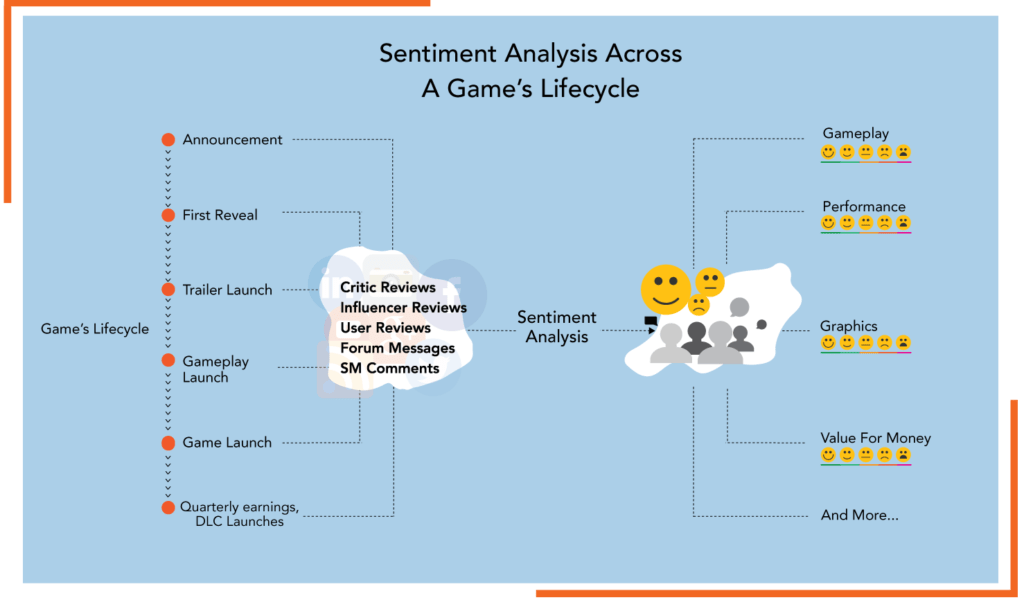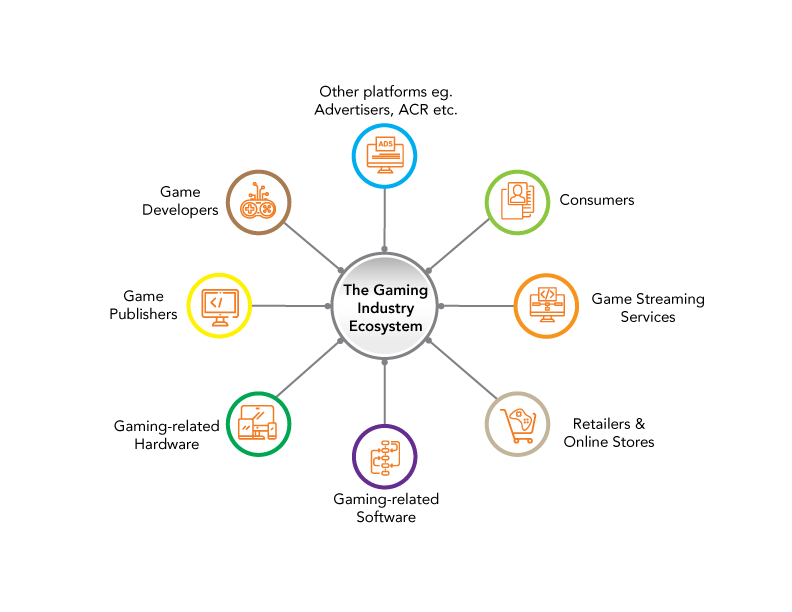Using Sentiment Analysis For Video Games
In today’s markets, the customer is at the top of the food chain. There are plenty of products which are your competitors as well as new ones being made. User opinions and reviews make or break a product and one of the industries where this is most apparent is gaming. A badly rated game has a direct correlation with the number of units of it sold. In comparing estimates of sales on Steam to aggregate review score averages, ArsTechnica found that better reviews do generally translate to more sales for games.
Sentiment analysis can be applied to all games, whether they’re successful or not, to improve them. It is a tool that can not only help you possibly fix your game, but by implementing it throughout your products’ lifecycles, you can improve the likelihood of success and overall quality.
Let’s say that you’re coming out with a new game. You’ve been working hard on it to ensure it’s what you imagined, and will be a hit with your audience. However, once it launches, it fails or just somehow, falls flat. You can think about why your game is failing but you might not be sure where the issues are. Sentiment analysis can help you with these problems.
What exactly is sentiment analysis, and why is it so important?
What is Sentiment Analysis?
Sentiment analysis is a powerful marketing tool that enables you to understand customer emotions. It detects positive or negative sentiments in text and is used to gauge brand reputation, gain insights on your customers’ needs, and see how your product is being received.
Sentiment analysis for video games involves tracking and analyzing real-time audience sentiments right from when a game is announced up till the present day. It uses Natural Language Processing (NLP) and Text Analysis techniques to highlight subjective information from text from your target audiences. It even anticipates your users’ actions. Sentiment analysis also monitors opinions for each individual aspect of the game ranging from the gameplay and graphics to the story, and more. Understanding what your users think can help you evolve your roadmap as needed to maximise success.
Gameopedia has created a detailed framework which takes the sentiments of not just customers, but also those of critics and influencers to provide a comprehensive view of the industry’s opinion of your game. This framework helps us track sentiments across various individual aspects of a game such as mechanics, audio design, and narrative.
How Sentiment Analysis Can Help Your Game:
Sentiment analysis can not only help you understand what people think about your product but brings way more to the table. When the insights from sentiment analysis are applied to your product roadmap, the benefits are myriad:
- Useful for understanding what people feel about your product during the ideation and development stages as well as post-release through surveys, competitor analysis, and the like.
- Helpful for analysing sentiments about your competition.
- Boosts sales and product reputation by implementing insights from analysis.
- Helpful for tracking sentiments across various individual aspects of a game like combat, characters, and the like.
- Helps improve product and brand recognition with your audience.
- Track the level of advertising success.– Measures customer loyalty and satisfaction.
- Aids in increasing customer retention.
Sentiment Analysis Throughout a Game’s Lifecycle
Sentiment analysis is a valuable tool because it can tell you what your audience thinks of your game right from when you announce it till date. This enables you to constantly improve and enhance it based on feedback which can drive up engagement and sales. Factors such as the quality of gameplay and narrative, how efficiently the game performs, the standard of graphics, the value for money it provides, and more are considered across the game’s lifecycle. Opinions for the aforementioned factors are derived from a variety of places such as critic and influencer reviews, user reviews, posts on social media and forums, and more. All of these taken into account can make your game significantly better. Let’s take a look at the game lifecycle and how sentiment analysis comes into play.
Planning and Pre-Production:
Using sentiment analysis during this stage can help you understand what game to make, what features to include, and ideate better. Competitor analysis is also something which you can do with sentiment analysis to see where your competitors are both winning and lacking and create content on that basis.
Announcement:
This can tell you whether the general idea of your game as well as the genres/ideas you have for it are received well or not. It can help improve the direction your game goes in.
First Reveal Stage and Trailer Launch:
Sentiment analysis here lets you track the buzz about your game on social media and lets you know whether it’s positive. You can also track separate sentiments about your company as well. For instance, response around your game might be mixed but feedback about your company might be positive.
Gameplay Footage Launch: Once you release footage of your game, look for sentiments about your gameplay breakdown. You can find out what your audience is hyped about or hates, be it world and audio design, character abilities, game mechanics, and more.
Game Launch: You would want to look for sentiments, positive or negative, about the game’s narrative, length, performance, gameplay, graphics, replay value, as well as any bugs or issues which might crop up so you can hot-fix or deal with them.
Post Game Launch: Once you’ve launched your game, you want to know whether your audience feels like it’s good value for money, as well as the overall opinion regarding it.
Updates/DLC Launches: Here you consider user and critic reviews and ratings apart from sentiments on social media and forums. You want to find out whether your new releases provide your customers with value for money, as well as what they feel about the quality of the releases.
Who Sentiment Analysis can Benefit
- Game Developers and Publishers: Apart from letting you know the overall sentiment about the game, negative feedback can help you identify specific problems that need to be solved while knowing your entire game isn’t negatively received. Positive sentiment about certain characters or mechanics can also be noted to create more content around them like DLCs.
- E-commerce Portals and Retailers: You will get an idea before a game’s launch about how it’s being received. When pre-order time is coming up, if the hype and sentiment surrounding a particular game is good, you can highlight or promote it to ensure more sales. On the contrary, if a game’s sentiments are negative, you can remove them from your list of recommendations and replace them with better performers.
- Advertisers/Marketers: Sentiment analysis is an excellent tool for knowing which games to market and promote, as well as help in identifying those with high click rates to focus on more. It can also help with monitoring brands and look at the volume of brand mentions, as well as the quality of those mentions.
- Game researchers and analysts: Sentiment analysis can help you understand games better, how they work, and learn more about them by looking at what your audience likes or dislikes about them.
The Challenges Associated with Sentiment Analysis
The biggest challenge for a sentiment analysis tool is to find technology that can understand nuance. Things which machine learning and NLP might have trouble with are:
- Polarity and Context: if you ask a question where you ask for likes and dislikes, even if a user likes your product, they might give sentiments based on whether your question is positive or negative.
- Irony and Sarcasm: People can express their negative sentiments using words which are detected as positive by machines. For instance, if someone asks if you like a game you don’t, you can be like “Yeah, sure, it was really fantastic <puke smiley>” which technology can have trouble interpreting.
- Emojis: When it comes to social media, especially tweets, a lot of them incorporate emojis which can be hard to read and interpret.
- Comparisons: Sometimes it can be hard for ML tools to understand whether comparisons being made are positive, negative, or neutral. A statement like “This is better than having nothing, I guess.” can be hard to classify.
- Individual Aspect Sentiment Identification: It can be hard to capture the sentiments for individual aspects of a game such as the gameplay mechanics, story, music, and the like.
We fact check our results manually to ensure we capture these nuances perfectly and to train our tool better.
Our Technology
Gameopedia’s vision for sentiment analysis is a hybrid of Machine Learning (ML) and Natural Language Processing (NLP) technology and human insights. The first two will help pick up on positive and negative keywords in text as our tool analyzes content from social media, forums, reviews, and the like, while the latter can help with nuance and things like sarcasm to make sure our analysis is accurate.

Gameopedia’s vision for sentiment analysis is a hybrid of Machine Learning (ML) and Natural Language Processing (NLP) technology and human insights. The first two will help pick up on positive and negative keywords in text as our tool analyzes content from social media, forums, reviews, and the like, while the latter can help with nuance and things like sarcasm to make sure our analysis is accurate.
If you require sentiment analysis for your needs, Gameopedia can help you out. We combine the latest in AI, NLP, and human expertise to accurately measure consumer and critic sentiment across user reviews, social media, discussion boards, editorials, web stores, and more. Talk to our game data experts or email us at [email protected].



